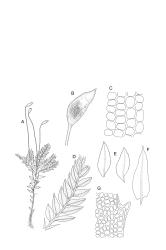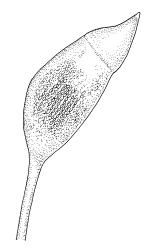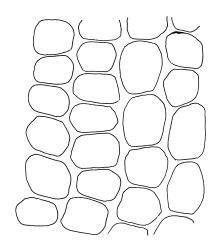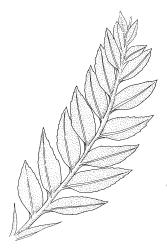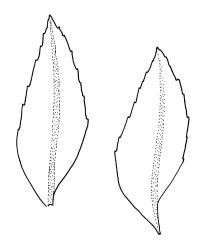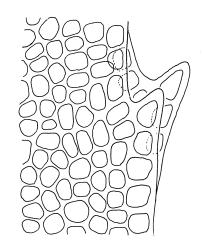- ≡ Hypnum bifarium Hook., Musci Exot. 1, 57 (1818)
- ≡ Rhizogonium bifarium (Hook.) Schimp. in Müller, Bot. Zeitung (Berlin) 5: 803 (1847)
- ≡ Hymenodontopsis bifaria (Hook.) N.E.Bell, A.E.Newton & D.Quandt, Bryologist 110: 555 (2007)
Plants small or medium-sized, 12–22 mm high, dark green, dendroid, forming turves. Stems erect, unbranched below and densely branched above (occasionally unbranched), red-brown below, becoming green above, c. 5–10 mm high (to the base of branching), not complanate, in cross-section five-angled, with 2–4 layers of small, thick-walled cells (the outermost strongly pigmented) gradually merging with the cortex and surrounding a small, distinct central strand, appearing zig-zag when leaves are removed, beset at base with brown, smooth, much branched rhizoids. Branches mostly 4–5 mm, with leaves distinctly 2-ranked and ± complanate. Stem leaves spreading, little crisped when dry, symmetric, ovate-lanceolate or lanceolate with an acuminate apex, not concave, narrowly but long-decurrent, bistratose and winged at margins, plane or narrowly recurved below, serrate nearly to base by 5–10 pairs of single-celled teeth, 1.6–2.0(–2.2) × 0.4–0.5 mm, becoming smaller and scale-like at stem base. Branch leaves more ovate and shorter than stem leaves, 1.0–1.8 × 0.3–0.4 mm, bifarious, somewhat asymmetric at base, not decurrent, with paired, single-celled teeth nearly to base and a subpercurrent costa. Upper laminal cells (of stem leaves) firm walled, irregular in outline but mostly ± isodiametric or oblong, a few longer and to 2:1, nearly all ≤15 µm in greater diam., becoming more oblate below, a small group at insertion obscure in outline and partially ± bistratose, sometimes more elongate (to 4:1); laminal cells of branch leaves similar; marginal cells (of stem and branch leaves) bistratose and forming 2 distinct wings (best viewed in cross-section), but not otherwise differentiated; alar cells not differentiated (both stem and branch leaves). Costa (of stem leaf) concolorous, c. 75–90 µm wide at base and evenly tapered, c. 30 µm wide at mid leaf, ending in the acumen, bearing several abaxial serrations near the apex, in cross section (at mid leaf) biconvex, with few median guide cells and 2 small stereid bands.
Dioicous. Perichaetia scattered on stems, with perichaetial leaves lanceolate and long acuminate, costate, c. 1.5 mm. Perigonia scattered on stem and branches, with bracts c. 2 mm, costate, long acuminate from an obovate, concave, and strongly pigmented base, with numerous antheridia and filiform, 6–8-celled paraphyses. Setae 14–35 mm, straight, smooth, twisting weakly to the left, bright red or red-brown. Capsules horizontal, obovoid, asymmetric, c. 1.5–1.8 mm, smooth, moderately constricted below the mouth when dry, pale brown, red-brown at mouth; exothecial cells in distinct longitudinal ranks (clearly visible under stereoscope), irregular oblong or quadrate, with thin transverse walls and strongly thickened longitudinal walls, mostly 30–54 × 30–39 µm, not striate; annulus vesicular and persistent; operculum high-conic, not rostrate, c. 0.8 mm long. Exostome teeth pale yellowish-brown, narrowly lanceolate, inserted c. 60 µm beneath the rim (exclusive of annulus), c. 460 µm long, bordered, outer surface transversely striate in lower half, baculate above, inner surface lamellate; endostome from a high membrane; segments as long as teeth, keeled, not or scarcely perforate; cilia single, nodose. Calyptra cucullate, covering only the operculum and upper portion of the capsule, c. 2.5 mm. Spores ± spherical, 15 µm, pale brown, very finely papillose.
Brotherus 1924, fig. 376 A–C (as Rhizogonium bifarium); Scott & Stone 1976, pl. 54 (as Rhizogonium bifarium); Beever et al. 1992, fig. 45 a–d.
NI: N Auckland, including offshore islands (LB), S Auckland, Gisborne, Hawke's Bay, Taranaki, Wellington. SI: Nelson, Marlborough, Canterbury, Westland, Otago, Southland; St; Ch; Sol; Sn; A; C.
Australasian. Tasmania*, mainland Australia*.
On rotten logs and stumps, also on tree bases, exposed roots, humic soil, and rarely on sandy soil. Rarely epiphytic on tree or tree fern trunks, or rock. Occurring in a variety of forest types but apparently absent from grasslands, and rare in peatlands. From c. 60 m (Logue’s Bush Scenic Reserve, N Auckland L.D.) to at least 950 m (near Lake Waikareiti, Gisborne L.D.) on North I; from near sea level (Dusky Sound, Southland L.D.) to 1095 m (near Flora Saddle, Nelson L.D.) on South I.
This is an exceedingly common and widespread species in N.Z. The dendroid habit and dimorphic leaves with the thickened margins and paired teeth, and scattered (non-basal) sex organs make this species unmistakable. Well-developed plants can look like minute palm trees in the field.
Occasional herbarium material of Leptotheca gaudichaudii is misnamed as this species, but the lack of double serrations, and the unbranched habit of Leptotheca permit ready differentiation.
The specimen (in herb. Hooker) interpreted here as the holotype consists of five tufts of one to five stems each, with mature, intact capsules and is labelled "No. 87. Dusky Bay New Zealand 1791" in Menzies’ script.




